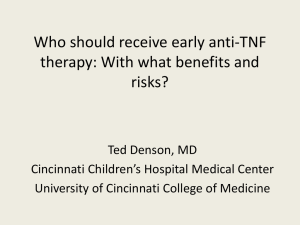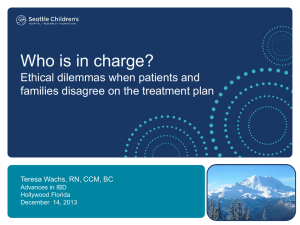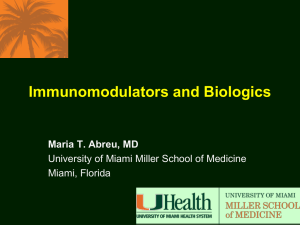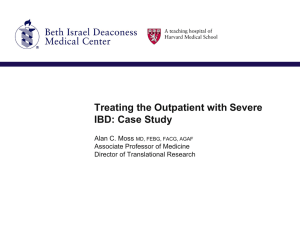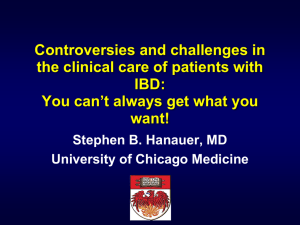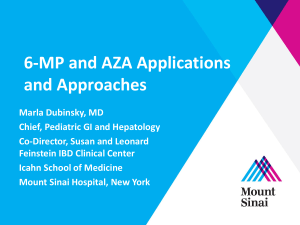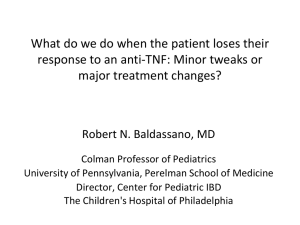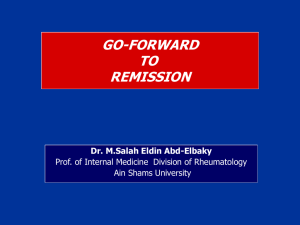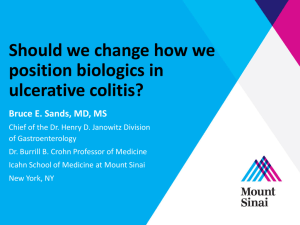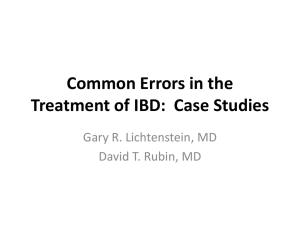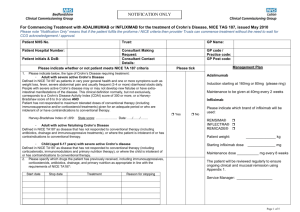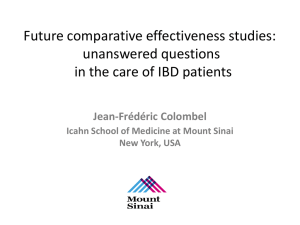P - Imedex
advertisement
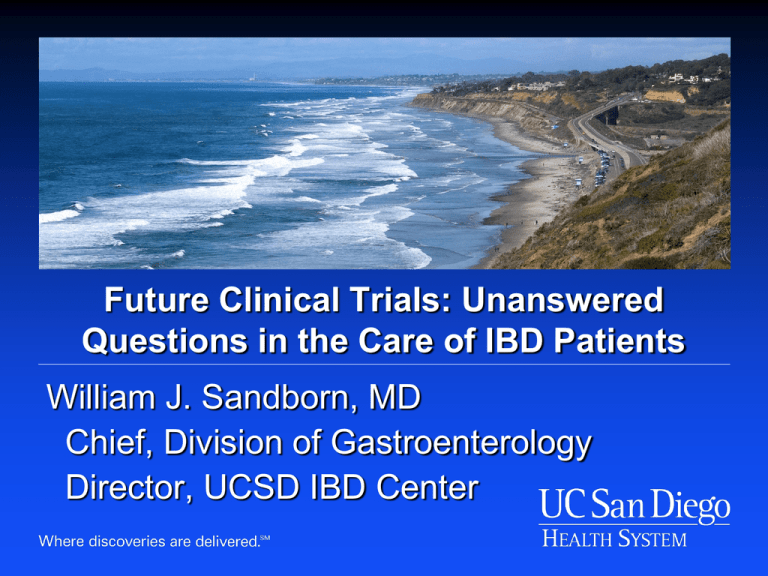
Future Clinical Trials: Unanswered Questions in the Care of IBD Patients William J. Sandborn, MD Chief, Division of Gastroenterology Director, UCSD IBD Center Unanswered Questions Step down Test Versus No Test Mucosal healing Prevention of postoperative recurrence Anti-TNF versus vedolizumab Step Down Withdrawal of AZA in 80 Patients With CD Treated With Scheduled IFX Maintenance: Clinical Outcomes No need for early rescue IFX No need to discontinue IFX 1.0 Continued Discontinued 0.8 0.6 0.4 Log rank (Cox): P=0.735 0.2 0.0 Proportion of Patients Proportion of Patients 1.0 0.8 Log rank (Cox): P=0.374 0.6 0.4 0.2 0.0 0 8 16 24 32 40 48 56 64 72 80 88 96 Weeks 0 8 16 24 32 40 48 56 64 72 80 88 96 104 Weeks Reprinted from Gastroenterology 134(7), Van Assche G, et al. Withdrawal of immunosuppression in Crohn's disease treated with scheduled infliximab maintenance: a randomized trial, 1861-1868. Copyright 2008, with permission from the AGA Institute. Withdrawal of AZA in CD Patients Treated With Scheduled IFX Maintenance: Serum CRP and IFX Concentrations Over Time 15 10 P<.005 5 1.6 Trough IFX (μg/mL) 0 2.8 Discontinued Continued 11 10 9 8 7 6 5 4 3 2 1 0 0 Con 8 16 24 32 P<.0001 2.87 1.65 1 Con 48 56 64 72 80 88 96 104 Weeks Continued Discontinued P=.0046 7 10 40 Dis [IFX] μg/mL CRP (mg/L) 20 CRP (mg/L) ** *** P=.11 6 5 P=.028 P=.043 P=.051 P=.048 P=.15 P=.19 4 3 2 1 0 Dis 0 8 16 24 32 40 48 56 64 72 80 88 96 104 20 18 19 18 18 18 17 18 Weeks Con N= Dis CRP, C-reactive protein 40 40 39 38 32 33 31 28 28 27 25 22 22 20 22 20 20 18 16 18 Reprinted from Gastroenterology 134(7), Van Assche G, et al. Withdrawal of immunosuppression in Crohn's disease treated with scheduled infliximab maintenance: a randomized trial, 1861-1868. Copyright 2008, with permission from the AGA Institute. STORI Trial Patients with Crohn's disease who were treated for at least 1 year with scheduled infliximab and an antimetabolite and had been in corticosteroid-free remission for at least 6 months Assessed the risk of relapse after discontinuation of infliximab in patients on combined maintenance therapy with immunosuppressors and to identify the risk factors for relapse Results: After 1 year of infliximab discontinuation, the relapse rate was 44% Patients who relapsed were successfully retreated with infliximab Of the 40 evaluable responses to retreatment at 4 weeks, 37 were in remission Predictive Factor CDEIS >0 hsCRP ≥5 mg/L Hemoglobin ≤14.5 g/dL Infliximab trough levels ≥2 μg/mL CDEIS, Crohn’s Disease Endoscopic Index of Severity; usCRP, ultrasensitive C-reactive protein Hazard Ratio P Value 2.3 3.2 6.0 2.5 0.04 <0.001 <0.001 0.02 Reprinted from Gastroenterology 141(1), Louis E, et al. Maintenance of remission among patients with Crohn's disease on antimetabolite therapy after infliximab therapy is stopped, 63-70. Copyright 2012, with permission from the AGA Institute. Test Versus No Test Factors Affecting the Pharmacokinetics of Monoclonal Antibodies IMPACT on PK Presence of ADAs Decreases serum [mAbs] Three fold-increased clearance Worse clinical outcomes Concomitant use of IS Reduces formation Increases serum [mAbs] Decreases mAbs clearance Better clinical outcomes High Baseline [TNF-α] May decrease [mAbs] by increasing clearance Low Albumin High Baseline CRP Body size Gender Increases clearance Worse clinical outcomes Increases clearance High BMI may increase clearance Males have higher clearance Ordas I, Feagan B, Mould D, Sandborn WJ. Clin Pharmacol Ther 2012 Proportion of patients (%) ACT 1+2: Proportions of Patients with Ulcerative Colitis Achieving Efficacy Endpoints by Serum Infliximab Concentrations <21.3 ≥21.3 – < 33.0 ≥33.0 – < 47.9 > 47.9 Reinisch W, et al., Digestive Disease Week 2012; Abstract # 566 <0.11 ≥0.11<2.4 ≥2.4<6.8 > 6.8 Elevating Infliximab Concentration from SubTherapeutic Levels is Effective in Regaining Response in HACA (-) Patients Clinical Outcomes of Patients with Detectable Antibodies to Infliximab or Sub-therapeutic Infliximab Concentrations Response to test Detectable HACA Subtherapeutic concentration Complete/partial response (%) Increase infliximab 1/6 (17) Change anti-TNF 11/12 (92) Increase infliximab 25/29 (86) Change anti-TNF 2/6 (33) Afif W, Sandborn WJ. Am J Gastroenterol 2010;105:1133-9. P value P<0.004 P<0.016 Treatment Algorithm in IBD Patients With Clinical Symptoms (Infliximab and HACA Concentrations) Positive HACA Change to another anti-TNF agent Therapeutic IFX concentration Active disease on endoscopy/radiology? yes no Subtherapeutic IFX concentration Increase infliximab dose or frequency Change to different anti-TNF agent Change to different anti-TNF agent Change to nonanti-TNF agent persistent disease Change to nonanti-TNF agent Change to different anti-TNF agent Afif W, et al. Am J Gastroenterol 2010;105:1133-9. Investigate alternate etiologies Mucosal Healing MUCOSAL HEALING AND TIME TO COLECTOMY IN INFLIXIMAB-TREATED PATIENTS 0 = NORMAL 1 = MILD 2 = MODERATE 3 = SEVERE Colombel JF, et al. Gastroenterology. 2011. Association Between Week 8 Mayo Endoscopy Subscore and and Corticosteroid-Free Symptomatic Remission at Week 30 During Anti-TNF Antibody Therapy Week 8 Mayo endoscopy subscore Corticosteroid-free symptomatic remission, % P value 0 46 < 0.001 1 34 2 11 3 6.5 Colombel JF, et al. Gastroenterology 2011 Working Definition of Deep Remission Overall, aiming for deep remission (DR) is managing disease beyond symptom control – In patients with no bowel damage or disability, DR is resolution of one or more objective measures of inflammation (endoscopy, markers, imaging) AND resolution of symptoms • To prevent damage and disability – In patients with existing bowel damage and disability, DR is resolution of one or more objective measures of inflammation (endoscopy, markers, imaging) AND improvement of symptoms if possible • To prevent further damage and disability, and reverse damage if possible Development of the Crohn’s Disease Digestive Damage Score, the Le´mann Score Benjamin Pariente, Jacques Cosnes, Silvio Danese, William J Sandborn, Maı¨te´ Lewin, Joel G Fletcher, Yehuda Chowers, Geert D’Haens, Brian G Feagan, Toshifumi Hibi, Daniel W Hommes, E. Jan Irvine, Michael A. Kamm, Edward V Loftus, Edouard Louis, Pierre Michetti, Pia Munkholm, Tom Oresland, Julian Pane´s, Laurent Peyrin-Biroulet, Walter Reinisch, Bruce E Sands, Juergen Schoelmerich, Stefan Schreiber, Herbert Tilg, Simon Travis, Gert van Assche, Maurizio Vecchi, Jean-Yves Mary, Jean-Fre´de´ric Colombel, Marc Le´mann Pariente B et al. Inflamm Bowel Dis. 2011;17(6):1415. Peyrin-Biroulet L et al. GUT. 2011. Inflammatory Activity and Progression of Damage in a Theoretical Patient with CD Digestive damage Surgery Fistula/abscess Stricture Disease onset Diagnosis Inflammatory activity (CDAI, CDEIS, CRP) Stricture Early disease CDAI, Crohn’s Disease Activity Index; CDEIS, Crohn’s disease endoscopic index of severity CRP; c-reactive protein Pariente B et al. Inflamm Bowel Dis. 2011;17(6):1415. All hospitalization (%) All-cause hospitalization through Week 52 20 17 15 10 5 0 0/11 9/53 Deep remission* (Week 12) Non-deep remission* (Week 12) CD-related hospitalization (%) EXTEND: patients with Crohn’s disease who achieved deep remission* with adalimumab at Week 12 and hospitalization rates CD-related hospitalization through Week 52 20 15 9 10 5 0 0/11 5/53 Deep remission* (Week 12) Non-deep remission* (Week 12) * Deep remission defined as clinical remission (CDAI <150) and complete mucosal healing in EXTEND CD: Crohn’s disease; CDAI: Crohn’s disease activity index Colombel JF, Sandborn WJ, et al. Gut 2010;59(Suppl 3):A80: OP371 at UEGW 2010 Prevention Of Postoperative Recurrence Crohn’s Disease: Recurrence After Surgery 100 Patients (%) 80 Survival without surgery 60 Survival without laboratory recurrence 40 Survival without symptoms 20 Survival without endoscopic lesions 0 0 1 2 3 4 5 6 7 8 Yr Rutgeerts P, et al. Gastroenterology. 1990;99(4):956 Infliximab for Prevention of Postoperative Recurrence in Crohn’s Disease Crohn’s disease patients with surgical resection of the ileum with an ileocolonic anastomosis 100 Placebo P=.0006 90 P=.0009 80 80 Infliximab 5 mg/kg P=.67 67 54 60 (%) 39 40 20 P=.05 15 15 8 0 0 Endoscopic remission Absence of CD on colonoscopy Clinical remission Clinical recurrence N=23; within 4 wk of surgery, patients received study drug at 0, 2, 6 wk then Q 8 wk for 1 yr Regueiro M, et al. Gastroenterology 2009 Anti-TNF Versus Vedolizumab Infliximab Induction and Maintenance Therapy in Patients with Ulcerative Colitis: Clinical Response ACT 1 Placebo IFX 5 mg/kg IFX 10 mg/kg ‡ 60 † ‡ 52 51 ‡ 46 44 50 37 30 30 20 20 10 80 ‡ 70 65 IFX 10 mg/kg ‡ 69 ‡ 60 ‡ 50 47 40 30 29 60 26 20 0 8 Weeks ‡P<.001 IFX 5 mg/kg 10 0 †P.002 % of Patients 69 ‡ 62 70 40 Placebo ‡ 80 % of Patients ACT 2 vs placebo vs placebo 30 Weeks 54 Weeks 8 Weeks 30 Weeks Rutgeerts P. N Engl J Med. 2005;353:2462. Infliximab Induction and Maintenance Therapy in Patients with Ulcerative Colitis: Clinical Remission ACT 1 ‡ 39 45 % of Patients 40 35 30 IFX 5 mg/kg ‡ 34 † 32 ‡ 37 ‡ ‡ 35 34 25 20 15 Placebo IFX 10 mg/kg 16 17 15 10 ‡P<.001 vs placebo vs placebo 36 ‡ † 26 20 15 10 0 †P.003 ‡ 25 0 54 Weeks IFX 10 mg/kg 28 30 5 30 Weeks 34 35 5 8 Weeks IFX 5 mg/kg ‡ 40 % of Patients Placebo ACT 2 11 6 8 Weeks 30 Weeks Rutgeerts P. N Engl J Med. 2005;353:2462. Infliximab Induction and Maintenance Therapy in Patients with Ulcerative Colitis: Mucosal Healing ACT 1 ‡ 70 62 60 % of Patients IFX 5 mg/kg Placebo ‡ 59 ‡ ‡ ‡ 50 49 34 30 25 18 20 60 ‡ 46 47 ‡ 62 50 46 40 31 57 30 30 20 0 0 54 Weeks IFX 10 mg/kg † 10 30 Weeks ‡ 60 10 8 Weeks IFX 5 mg/kg ‡ 70 50 40 IFX 10 mg/kg % of Patients Placebo ACT 2 8 Weeks 30 Weeks Mucosal healing = endoscopic subscore of 0 or 1 †P.009 ‡P<.001 vs placebo vs placebo Rutgeerts P. N Engl J Med. 2005;353:2462. Vedolizumab (Anti-Alpha 4 Beta 7 Integrin) For Moderately-toSeverely Active Ulcerative Colitis: Results at Week 6 in 374 Patients P<0.001 P=0.0012 P=0.0009 Feagan B. DDW 2012 Late Breaking Abstract Vedolizumab (Anti- 47 Integrin) For Maintenace of Response in Moderately-to-Severely Active Ulcerative Colitis: Results at Week 52 in 373 Patients Feagan B. ACG 2012 Abstract Comparative Effectiveness Trials Already Completed But Results Not Fully Implemented By Clinicians Mesalamine not effective for Crohn’s disease SONIC and UC Success – azathioprine < infliximab < combination therapy Early use of azathioprine + steroids not more effective than a tapering course of steroids Conclusions Comparative effectiveness studies are needed to better guide future clinical practice
